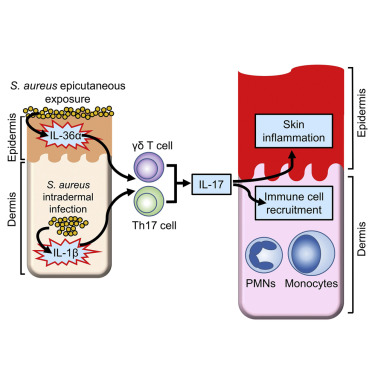当前位置:
X-MOL 学术
›
Cell Host Microbe
›
论文详情
Our official English website, www.x-mol.net, welcomes your
feedback! (Note: you will need to create a separate account there.)
Staphylococcus aureus Epicutaneous Exposure Drives Skin Inflammation via IL-36-Mediated T Cell Responses.
Cell Host & Microbe ( IF 20.6 ) Pub Date : 2017-11-08 , DOI: 10.1016/j.chom.2017.10.006 Haiyun Liu 1 , Nathan K Archer 1 , Carly A Dillen 1 , Yu Wang 1 , Alyssa G Ashbaugh 1 , Roger V Ortines 1 , Tracy Kao 1 , Steven K Lee 1 , Shuting S Cai 1 , Robert J Miller 1 , Mark C Marchitto 1 , Emily Zhang 1 , Daniel P Riggins 2 , Roger D Plaut 2 , Scott Stibitz 2 , Raif S Geha 3 , Lloyd S Miller 4
Cell Host & Microbe ( IF 20.6 ) Pub Date : 2017-11-08 , DOI: 10.1016/j.chom.2017.10.006 Haiyun Liu 1 , Nathan K Archer 1 , Carly A Dillen 1 , Yu Wang 1 , Alyssa G Ashbaugh 1 , Roger V Ortines 1 , Tracy Kao 1 , Steven K Lee 1 , Shuting S Cai 1 , Robert J Miller 1 , Mark C Marchitto 1 , Emily Zhang 1 , Daniel P Riggins 2 , Roger D Plaut 2 , Scott Stibitz 2 , Raif S Geha 3 , Lloyd S Miller 4
Affiliation

|
Staphylococcus aureus colonization contributes to skin inflammation in diseases such as atopic dermatitis, but the signaling pathways involved are unclear. Herein, epicutaneous S. aureus exposure to mouse skin promoted MyD88-dependent skin inflammation initiated by IL-36, but not IL-1α/β, IL-18, or IL-33. By contrast, an intradermal S. aureus challenge promoted MyD88-dependent host defense initiated by IL-1β rather than IL-36, suggesting that different IL-1 cytokines trigger MyD88 signaling depending on the anatomical depth of S. aureus cutaneous exposure. The bacterial virulence factor PSMα, but not α-toxin or δ-toxin, contributed to the skin inflammation, which was driven by IL-17-producing γδ and CD4+ T cells via direct IL-36R signaling in the T cells. Finally, adoptive transfer of IL-36R-expressing T cells to IL-36R-deficient mice was sufficient for mediating S. aureus-induced skin inflammation. Together, this study defines a previously unknown pathway by which S. aureus epicutaneous exposure promotes skin inflammation involving IL-36R/MyD88-dependent IL-17 T cell responses.
中文翻译:

金黄色葡萄球菌表皮暴露通过 IL-36 介导的 T 细胞反应驱动皮肤炎症。
金黄色葡萄球菌定植会导致特应性皮炎等疾病的皮肤炎症,但所涉及的信号通路尚不清楚。在此,表皮金黄色葡萄球菌暴露于小鼠皮肤会促进由 IL-36 引发的 MyD88 依赖性皮肤炎症,但不会促进 IL-1α/β、IL-18 或 IL-33。相比之下,皮内金黄色葡萄球菌挑战促进了由 IL-1β 而不是 IL-36 引发的 MyD88 依赖性宿主防御,这表明不同的 IL-1 细胞因子触发 MyD88 信号传导取决于金黄色葡萄球菌皮肤暴露的解剖深度。细菌毒力因子 PSMα,而不是 α-毒素或 δ-毒素,促成了皮肤炎症,这是由产生 IL-17 的 γδ 和 CD4+ T 细胞通过 T 细胞中的直接 IL-36R 信号传导驱动的。最后,将表达 IL-36R 的 T 细胞过继转移至 IL-36R 缺陷小鼠足以介导金黄色葡萄球菌诱导的皮肤炎症。总之,这项研究定义了一个以前未知的途径,金黄色葡萄球菌表皮暴露通过该途径促进涉及 IL-36R/MyD88 依赖性 IL-17 T 细胞反应的皮肤炎症。
更新日期:2017-11-08
中文翻译:

金黄色葡萄球菌表皮暴露通过 IL-36 介导的 T 细胞反应驱动皮肤炎症。
金黄色葡萄球菌定植会导致特应性皮炎等疾病的皮肤炎症,但所涉及的信号通路尚不清楚。在此,表皮金黄色葡萄球菌暴露于小鼠皮肤会促进由 IL-36 引发的 MyD88 依赖性皮肤炎症,但不会促进 IL-1α/β、IL-18 或 IL-33。相比之下,皮内金黄色葡萄球菌挑战促进了由 IL-1β 而不是 IL-36 引发的 MyD88 依赖性宿主防御,这表明不同的 IL-1 细胞因子触发 MyD88 信号传导取决于金黄色葡萄球菌皮肤暴露的解剖深度。细菌毒力因子 PSMα,而不是 α-毒素或 δ-毒素,促成了皮肤炎症,这是由产生 IL-17 的 γδ 和 CD4+ T 细胞通过 T 细胞中的直接 IL-36R 信号传导驱动的。最后,将表达 IL-36R 的 T 细胞过继转移至 IL-36R 缺陷小鼠足以介导金黄色葡萄球菌诱导的皮肤炎症。总之,这项研究定义了一个以前未知的途径,金黄色葡萄球菌表皮暴露通过该途径促进涉及 IL-36R/MyD88 依赖性 IL-17 T 细胞反应的皮肤炎症。











































 京公网安备 11010802027423号
京公网安备 11010802027423号